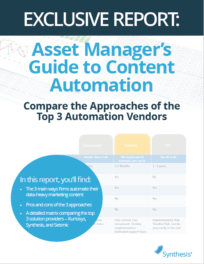How to Prep your Team for Content Automation

As Ben Franklin once said, “By failing to prepare, you are preparing to fail.”
Preparation is critical to the outcome of a content automation initiative. There’s always a possibility implementation will go awry if the project plan is disorganized. Organization and planning are challenging, for it takes specific business and leadership skills to run this kind of technical project. Many departments need to get involved, including marketing, IT, sales, and compliance. Stakeholders from each department must re-examine their processes and work together to re-create them for automation. The goal is to improve the process fundamentally and permanently within the boundaries of a systemized solution. More often than not, this is easier said than done, and may require professional assistance. Here are 5 best practices to prime your team for content automation.
1 – Assign a strong, cross-functional leader
“A strong leader is one who knows the way, goes the way, and shows the way.” – John C. Maxwell
Successful automation projects are lead by someone who has rallied appropriate stakeholders to decide collectively on the end goal, and who will lead and inspire the team to completion. One of our senior project managers recently relayed a story about a strong leader who positively impacted an implementation.
“We had a new client a few years ago who held a large kickoff meeting with all the major participants of the project. The division head spoke to the group and expressed his excitement about the project, and reiterated his expectations for everyone to give their full effort and cooperation to ensure it was completed successfully. He explained why the project was important and how it was going to help the organization. He set a really good tone early on and helped everyone understand that the project was not just “busy work”. If there was anyone in the room who had doubts about the project and why it was necessary, I’m confident they left the meeting with a better understanding and attitude about the project. It was a very successful implementation and everyone was very helpful throughout. I am not saying that without the meeting it would not have been successful, but it sure did help the energy of the team.”
Communication and strong leadership are integral to the overall strategy and planning process.
2 – Document the project plan
A clearly documented project plan keeps everyone on the same page so they understand the goals they are working toward, outlines the steps and phases, and keeps the project on track by assigning deadlines. The project plan should include:
- A roster of people involved in the project and a description of each person’s role. This list might include the project sponsor, project manager, data steward, marketing communications manager, website manager, fund accounting, fund management, and other key users or contributors.
- A pre-set meeting schedule. We recommend a weekly meeting to discuss and resolve issues, as well as a monthly oversight meeting to make sure the strategy is still sound.
- An outline of critical milestones and a project timeline, by phase. This is the meat of the project plan, where you will document each item that needs to be completed with responsible party and deadlines. Each item should always assign an individual owner, so there is no confusion on who is doing what.
- As part of our turnkey service, we provide a detailed project plan for each of our client implementations. If you’d like a sample, please contact us to request one from our team.
3 – Build a data ‘dictionary’
Before a content automation implementation, it’s a good idea to build a data dictionary to document where each data point comes from (the data source) and how stable or reliable that source is. A dictionary might include:
- Data Element
- Data Source
- Data Type
- How it is loaded (manual or feed)
- Calculation method
- Business Rule dependencies
- Where the data is currently stored
- How the data is currently accessed
- Delivery/Update cycle
- Data Steward
When it comes to data, a high-level of detail and organization is extremely helpful when you are planning to automate any data-heavy content such as fact sheets, commentaries, and pitchbooks. Part of this process may be an analysis on areas of improvement like where the data is stored and how the data is accessed. Click here to download our guide to data integration for content automation.
4 – Document and organize your business rules
As part of your data dictionary, it’s important to clearly outline your business rules for visually displaying your data (i.e., charts and graphs). For example, how will the data display if the fund is less than 5 years old? Where is the data being pulled from? What are the associated disclosures or footnotes that accompany the chart?
Here is a helpful guide for documenting your business rules.
5 – Optimize your template designs for automation
When considering template designs for automation, it’s necessary to first understand the system you’re using and how it works. Each system will have some limitations as well as strengths. You’ll need to consider the format required for the system (PowerPoint, Word, InDesign, etc) and whether you’ll need to migrate to a new format. You’ll also want to consider consolidating your templates and streamlining the design to make the solution as efficient as possible. When the template design is done effectively, it improves the overall results of the automation. It’s best to work in collaboration with a qualified vendor to design and optimize your templates for automation.
Here’s a guide that talks about designing and re-branding your fact sheets for automation.
Consider Hiring an Implementation Expert
Implementing content automation can be challenging. There are several factors that can derail these projects, especially if it’s the first time your team has tackled an automation setup. Working with a qualified vendor or partner can ensure you have a positive experience and see expected results. Once the system is set up and any hiccups are ironed out, the automated solution will be a game-changer for your organization. Not only does it help mitigate risk and improve time-to-market, but your team can get out of the trenches and into the strategic initiatives that move your business forward.
If you have questions about choosing the right content automation approach or need ideas on how to successfully plan for implementation, please get in touch! We’d be happy to discuss some ideas with you. Follow us on LinkedIn for more insights.
Here are some related resources that might interest you:






 Compare the Top 3 Finserv Content Automation Vendors [White paper]
Compare the Top 3 Finserv Content Automation Vendors [White paper] Create Pitchbooks the Drive Sales [White paper]
Create Pitchbooks the Drive Sales [White paper] Build vs. Buy: Should Your Financial Services Firm Outsource or Insource Marketing Technology? [White paper]
Build vs. Buy: Should Your Financial Services Firm Outsource or Insource Marketing Technology? [White paper]  10 Tips for Rebranding your Fund Marketing Documents [White paper]
10 Tips for Rebranding your Fund Marketing Documents [White paper]




